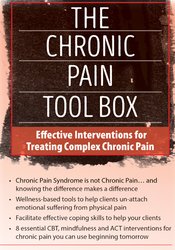Description
- Chronic Pain Syndrome is not Chronic Pain… and knowing the difference makes a difference
- Wellness-based tools to help clients un-attach emotional suffering from physical pain
- Facilitate effective coping skills to help your clients
- 8 essential CBT, mindfulness and ACT interventions for chronic pain you can use beginning tomorrow
Years ago, I sat down to evaluate a potential client with chronic pain. A minute hadn’t passed before she broke down in tears while describing a 5-year-old injury that left her with excruciating neck pain. Despite 3 back surgeries and countless procedures, her back was still “killing” her and she placed her pain at 15/10. She couldn’t sleep, she had gained weight and couldn’t exercise. She had stopped working, was in a lawsuit over the injury, and was afraid to leave the house. Her doctor had placed her on high doses of an opiate pain killer plus an anti-anxiety medication and she admitted that sometimes she took more than she was prescribed. She admitted to having suicidal thoughts because she had lost hope that she might ever get her life back.
Now imagine yourself in my place. How would you conduct an effective assessment? Do you know the difference between chronic pain and a chronic pain syndrome? What might be the best approach to treat pain and a co-occurring disorder? Are you confident you have enough evidence-based skills in your toolbox to help clients help themselves?
This is a challenging time to treat complex chronic pain. Over 100 million Americans experience some form of chronic pain and the country is struggling with a tragic opiate epidemic that has cost tens of thousands of lives and is ripping society apart. As a clinician, you are in unique position to provide effective pain management to your chronic pain clients… but only if you fill your invisible toolbox with the evidence-based skills that work.
In this interactive and creative seminar, we will focus on the assessment and treatment of complex chronic pain. You will learn how to evaluate it and how to discern and manage co-occurring disorders. You will increase your confidence in your ability to transform your knowledge of CBT, mindfulness, and ACT into the “silver bullet” skills that can facilitate “inside-out” pain management that empowers your clients. You will leave this seminar with 8 practical interventions you can begin to use tomorrow to motivate your clients to commit to the changes they want and to assist their families in finding the resources they need.
CPD
CPD
This online program is worth 6.25 hours CPD.
Speaker
Treatment Rehab Professionals LLC
Objectives
- Specify the difference between chronic pain and a complex chronic pain syndrome and how conventional treatments (including MAT, procedures, and surgery) often “make it worse.”
- Delineate the difference between physical pain and emotional suffering and how the 5 Big Negative Emotions magnify the pain experience as it relates to clinical practice.
- Establish the ability to conduct an effective biopsychosocial assessment of chronic pain and use pain scales to recalibrate pain levels and increase wellness in a clinical setting.
- Utilize cognitive restructuring to assist clients in creating “black duck moments” in session that will change their perspective on their pain experiences and motivate them to live more active and purposeful lives.
- Practice 3 ACT interventions to defuse the impact of chronic pain and increase client commitment to positive behavioral change for symptom management.
- Implement 4 mindfulness-based interventions to empower clients to manage their pain by going FAR.
- Integrate the power of gratitude into your practice to decrease pain and increase wellness to improve treatment outcomes.
- Develop the competency to guide a multidisciplinary approach to pain management that connects pain clients and families to resources beyond therapy to improve client level of functioning.
Outline
- The Chronic Pain Dilemma
- Pain and its impact on society
- Neurophysiology and psychology of pain
- Benefits and the risks of opioids
- Pain and the family
- Complex Chronic Pain
- The progression from acute to chronic pain (physical and emotional factors)
- Chronic pain syndrome and its constellation of symptoms
- Conventional treatments and why they fail
- Pain vs suffering: What are we really treating?
- The 5 big “negative” emotions that magnify pain
- The number one rule in pain management
- Strategies to un-attach pain from suffering
- Assessment
- The Interview
- Validation and the therapeutic alliance
- Collect a biopsychosocial history
- Co-occurring disorders and other risk factors
- The Battery
- Useful self-report measures
- Interpretation of results for case conceptualization
- Effective treatment planning
- The Chronic Pain Toolbox
- Best Practice Guidelines and treatment options
- APA Division 12 recommendations
- CDC and government recommendations
- Empathy and the power of the therapeutic alliance
- Cognitive Behavioral Therapy
- Unleash “black ducks” to eat up ANTs
- Harness the power of client’s own words
- Recalibrate Pain: a cognitive approach
- Mindfulness
- Why mindfulness is essential for the treatment of chronic pain
- 4 creative interventions to help clients see “What is NOT wrong with me”
- The FAR approach and how it resonates with clients
- Limitations of the psychotherapeutic approach
- Acceptance and Commitment Therapy
- Cognitive defusion and how to use it with clients
- The Values Compass and how to help clients find their True North
- Develop motivation and commitment
- Limitations of the psychotherapeutic approach
- Gratefulness
- The hidden power of gratefulness and its evidence for chronic pain
- 3 gratitude interventions that directly impact the pain experience
- More Tools You Can Use
- Include the family in treatment
- Effective sleep hygiene
- Multidisciplinary treatments: when and how to use them
- The T.E.M.P.L.E.S.S hand-out you can share with clients
- Patient advocate resources
- Recovery resources
Target Audience
Social Workers, Psychologists, Counselors, Addiction Counselors, Psychotherapists,
Occupational Therapists, Case Managers, Marriage and Family Therapists, Physical Therapists, Physical Therapist Assistants, Nurse Practitioners, Nurses, Other Helping Professionals
Reviews
Overall:
4.9
Total Reviews: 8


 Online CourseFrank Anderson’s Master Class in Internal Family Systems Therapy£129.98£999.98Frank Anderson’s Master Class in Internal Family Systems Therapy29 Jan, 2024Frank Anderson’s Master Class in Internal Family Systems Therapy£129.98£999.98 value
Online CourseFrank Anderson’s Master Class in Internal Family Systems Therapy£129.98£999.98Frank Anderson’s Master Class in Internal Family Systems Therapy29 Jan, 2024Frank Anderson’s Master Class in Internal Family Systems Therapy£129.98£999.98 value Online CourseDr Laurel Parnell’s Attachment-Focused EMDR Skills and Supervision Group£495.00£1,590.00Dr Laurel Parnell’s Attachment-Focused EMDR Skills and Supervision Group14 Jan, 2025Dr Laurel Parnell’s Attachment-Focused EMDR Skills and Supervision Group£495.00£1,590.00 value
Online CourseDr Laurel Parnell’s Attachment-Focused EMDR Skills and Supervision Group£495.00£1,590.00Dr Laurel Parnell’s Attachment-Focused EMDR Skills and Supervision Group14 Jan, 2025Dr Laurel Parnell’s Attachment-Focused EMDR Skills and Supervision Group£495.00£1,590.00 value BookWritten by three leading experts in the fields of disordered eating, mental health, and trauma-informed care, this book will become your go-to guide for learning how to reject diet culture, heal your£18.99Written by three leading experts in the fields of disordered eating, mental health, and trauma-informed care, this book will become your go-to guide for learning how to reject diet culture, heal your20 Feb, 2024Written by three leading experts in the fields of disordered eating, mental health, and trauma-informed care, this book will become your go-to guide for learning how to reject diet culture, heal your£18.99
BookWritten by three leading experts in the fields of disordered eating, mental health, and trauma-informed care, this book will become your go-to guide for learning how to reject diet culture, heal your£18.99Written by three leading experts in the fields of disordered eating, mental health, and trauma-informed care, this book will become your go-to guide for learning how to reject diet culture, heal your20 Feb, 2024Written by three leading experts in the fields of disordered eating, mental health, and trauma-informed care, this book will become your go-to guide for learning how to reject diet culture, heal your£18.99 Online CourseCBT-I To Treat Insomnia: Proven Interventions That Go Beyond Sleep Hygiene£0.00£149.00CBT-I To Treat Insomnia: Proven Interventions That Go Beyond Sleep Hygiene12 Dec, 2024CBT-I To Treat Insomnia: Proven Interventions That Go Beyond Sleep Hygiene£0.00£149.00 value
Online CourseCBT-I To Treat Insomnia: Proven Interventions That Go Beyond Sleep Hygiene£0.00£149.00CBT-I To Treat Insomnia: Proven Interventions That Go Beyond Sleep Hygiene12 Dec, 2024CBT-I To Treat Insomnia: Proven Interventions That Go Beyond Sleep Hygiene£0.00£149.00 value












